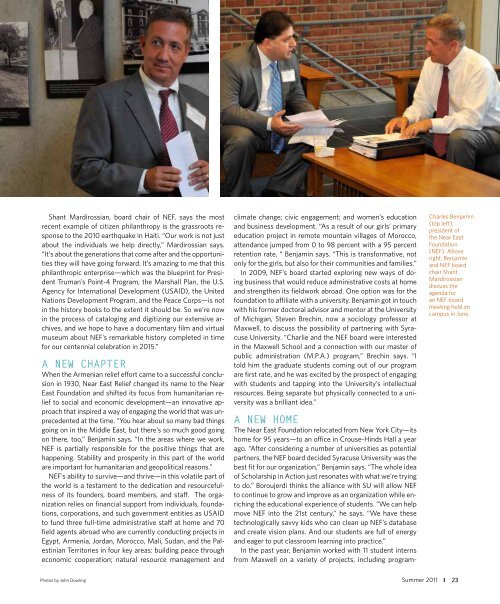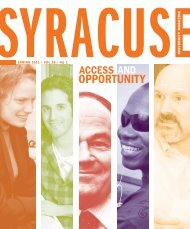Summer 2011.pdf - Syracuse University Magazine
Summer 2011.pdf - Syracuse University Magazine
Summer 2011.pdf - Syracuse University Magazine
You also want an ePaper? Increase the reach of your titles
YUMPU automatically turns print PDFs into web optimized ePapers that Google loves.
Shant Mardirossian, board chair of NEF, says the most<br />
recent example of citizen philanthropy is the grassroots response<br />
to the 2010 earthquake in haiti. “Our work is not just<br />
about the individuals we help directly,” Mardirossian says.<br />
“It’s about the generations that come after and the opportunities<br />
they will have going forward. It’s amazing to me that this<br />
philanthropic enterprise—which was the blueprint for President<br />
truman’s Point-4 Program, the Marshall Plan, the U.S.<br />
Agency for International Development (USAID), the United<br />
Nations Development Program, and the Peace Corps—is not<br />
in the history books to the extent it should be. So we’re now<br />
in the process of cataloging and digitizing our extensive archives,<br />
and we hope to have a documentary film and virtual<br />
museum about NEF’s remarkable history completed in time<br />
for our centennial celebration in 2015.”<br />
A new chAPter<br />
When the Armenian relief effort came to a successful conclusion<br />
in 1930, Near East Relief changed its name to the Near<br />
East Foundation and shifted its focus from humanitarian relief<br />
to social and economic development—an innovative approach<br />
that inspired a way of engaging the world that was unprecedented<br />
at the time. “you hear about so many bad things<br />
going on in the Middle East, but there’s so much good going<br />
on there, too,” Benjamin says. “In the areas where we work,<br />
NEF is partially responsible for the positive things that are<br />
happening. Stability and prosperity in this part of the world<br />
are important for humanitarian and geopolitical reasons.”<br />
NEF’s ability to survive—and thrive—in this volatile part of<br />
the world is a testament to the dedication and resourcefulness<br />
of its founders, board members, and staff. the organization<br />
relies on financial support from individuals, foundations,<br />
corporations, and such government entities as USAID<br />
to fund three full-time administrative staff at home and 70<br />
field agents abroad who are currently conducting projects in<br />
Egypt, Armenia, jordan, Morocco, Mali, Sudan, and the Palestinian<br />
territories in four key areas: building peace through<br />
economic cooperation; natural resource management and<br />
Photos by john Dowling<br />
climate change; civic engagement; and women’s education<br />
and business development. “As a result of our girls’ primary<br />
education project in remote mountain villages of Morocco,<br />
attendance jumped from 0 to 98 percent with a 95 percent<br />
retention rate, “ Benjamin says. “this is transformative, not<br />
only for the girls, but also for their communities and families.”<br />
In 2009, NEF’s board started exploring new ways of doing<br />
business that would reduce administrative costs at home<br />
and strengthen its fieldwork abroad. One option was for the<br />
foundation to affiliate with a university. Benjamin got in touch<br />
with his former doctoral advisor and mentor at the <strong>University</strong><br />
of Michigan, Steven Brechin, now a sociology professor at<br />
Maxwell, to discuss the possibility of partnering with <strong>Syracuse</strong><br />
<strong>University</strong>. “Charlie and the NEF board were interested<br />
in the Maxwell School and a connection with our master of<br />
public administration (M.P.A.) program,” Brechin says. “I<br />
told him the graduate students coming out of our program<br />
are first rate, and he was excited by the prospect of engaging<br />
with students and tapping into the <strong>University</strong>’s intellectual<br />
resources. Being separate but physically connected to a university<br />
was a brilliant idea.”<br />
A new hoMe<br />
the Near East Foundation relocated from New york City—its<br />
home for 95 years—to an office in Crouse-hinds hall a year<br />
ago. “After considering a number of universities as potential<br />
partners, the NEF board decided <strong>Syracuse</strong> <strong>University</strong> was the<br />
best fit for our organization,” Benjamin says. “the whole idea<br />
of Scholarship in Action just resonates with what we’re trying<br />
to do.” Boroujerdi thinks the alliance with SU will allow NEF<br />
to continue to grow and improve as an organization while enriching<br />
the educational experience of students. “We can help<br />
move NEF into the 21st century,” he says. “We have these<br />
technologically savvy kids who can clean up NEF’s database<br />
and create vision plans. And our students are full of energy<br />
and eager to put classroom learning into practice.”<br />
In the past year, Benjamin worked with 11 student interns<br />
from Maxwell on a variety of projects, including program-<br />
<strong>Summer</strong> 2011<br />
Charles Benjamin<br />
(top left),<br />
president of<br />
the Near East<br />
Foundation<br />
(NEF). Above<br />
right, Benjamin<br />
and NEF board<br />
chair Shant<br />
Mardirossian<br />
discuss the<br />
agenda for<br />
an NEF board<br />
meeting held on<br />
campus in june.<br />
23




